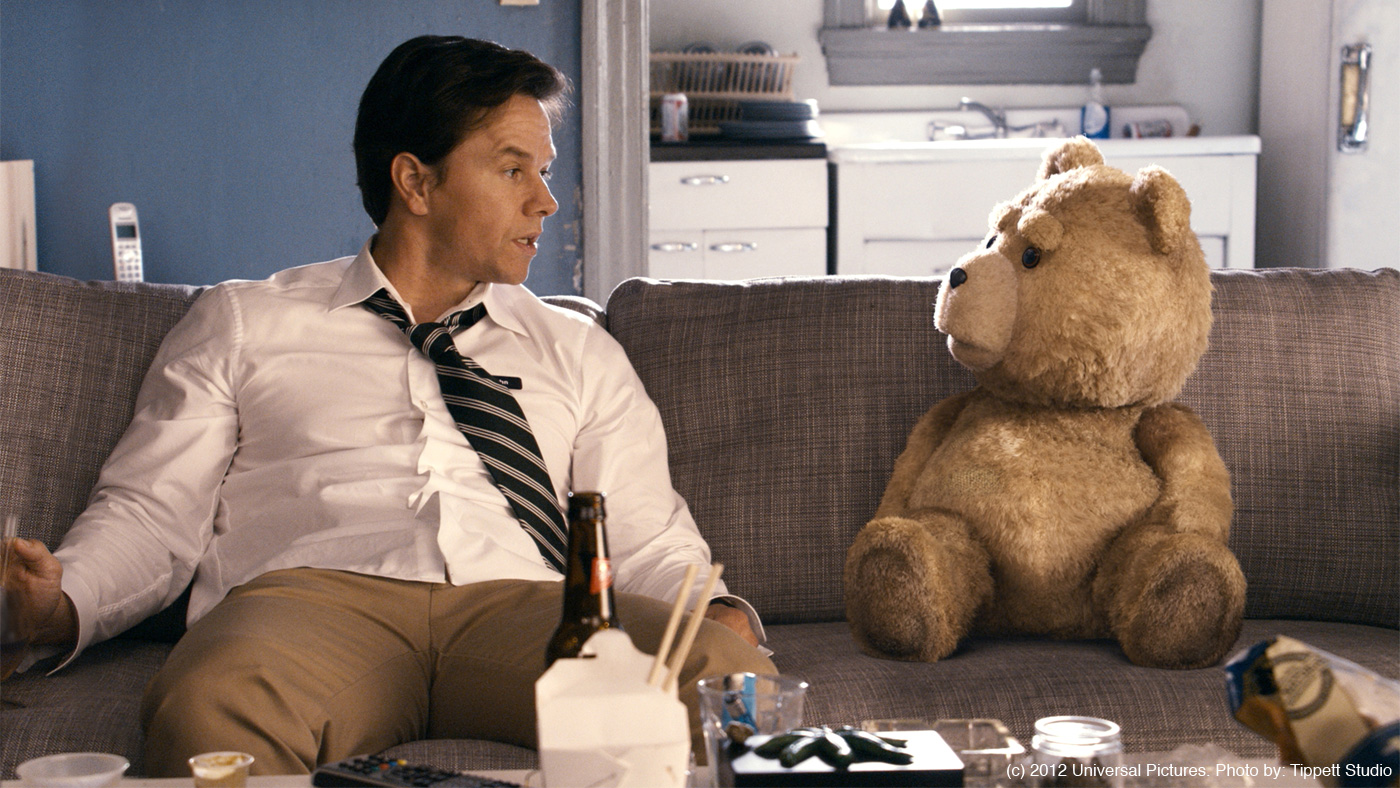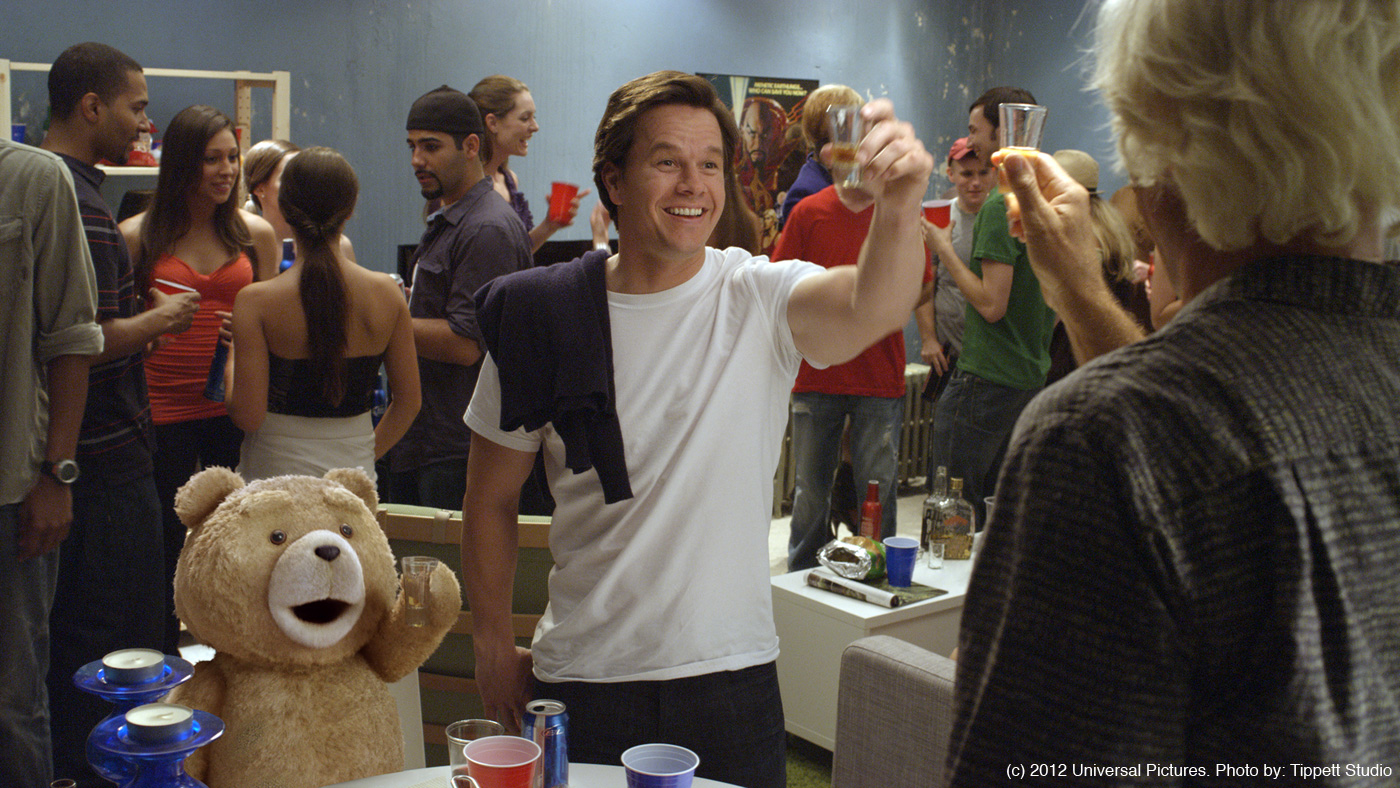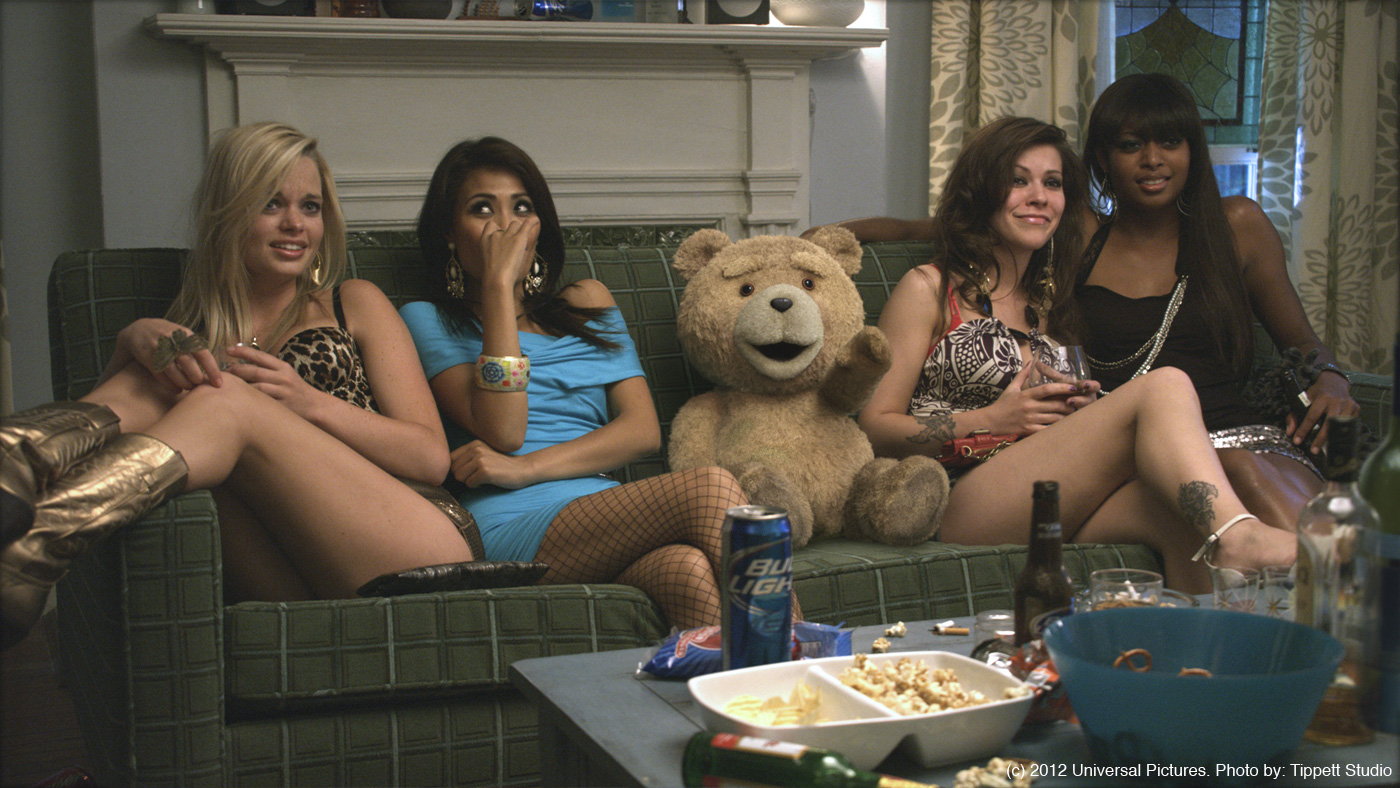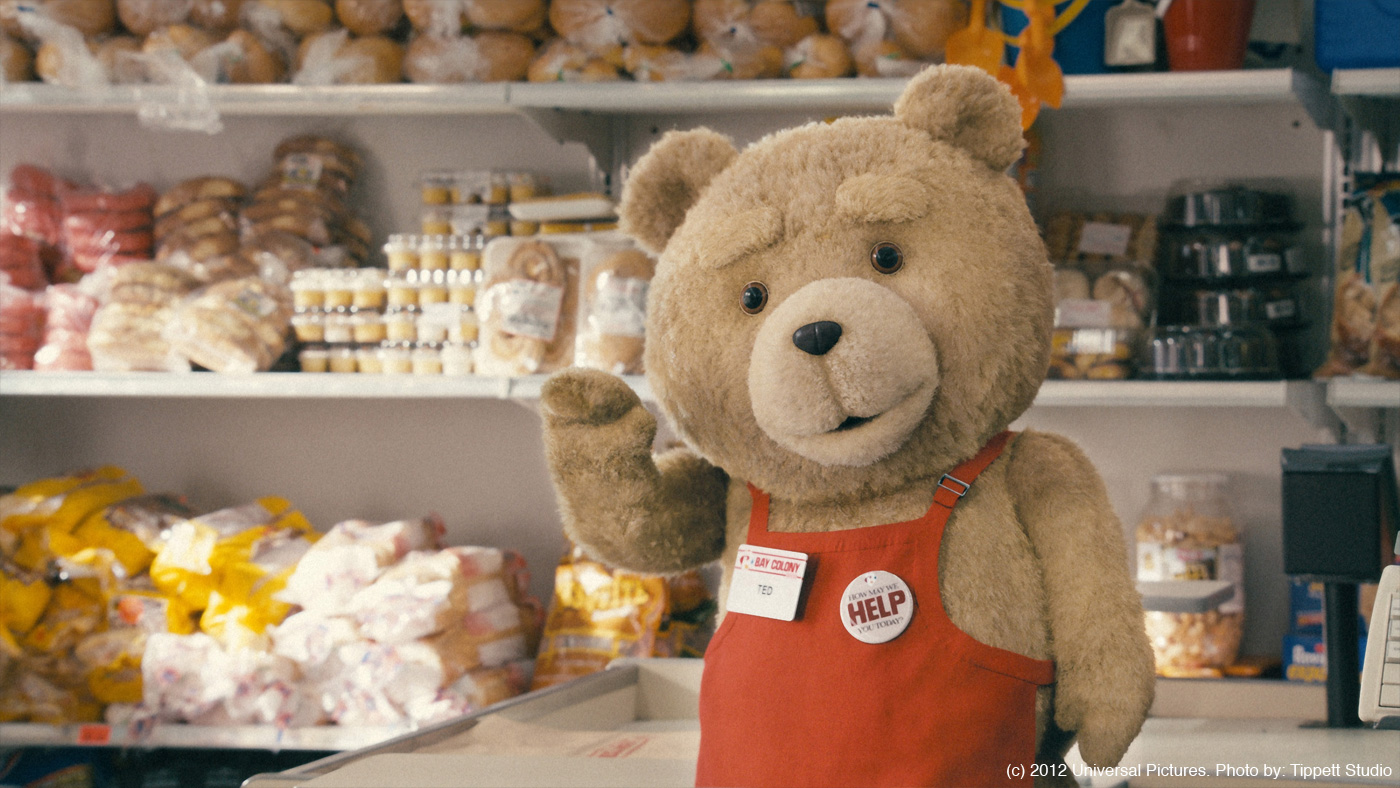Since he explained the effects of Tippett Studio on SEASON OF THE WITCH, Blair Clark worked on films like PRIEST and THE SMURFS.
How did Tippett got involved on this show?
I was contacted by Jenny Fulle, asking me if I would be interested in supervising a show about a pot smoking, skirt chasing teddy bear directed by Seth Macfarlane. Jenny and I have known each other for 30+ years and we had recently worked with her company, The Creative Cartel on a previous film.
I was so excited (of course I responded with enthusiastic YES!) The script was really great, very funny, sweet, and deliciously irreverent, and had a solid story. Ted was going to be a main character, not just a supporting side-kick, etc. but have to hold his own in looking real and truly act with HIS co-star! It wasn’t going to be easy, but getting a chance to work with Seth Macfarlane was very exciting, and working with Jenny and her team again was also something I was really looking forward to.
I was hired as the production VFX Supervisor.
At Tippett Studio, we had Scott Liedtka in place as VFX Supervisor, Jim Brown as Animation Supervisor, and Fiona Chilton as VFX Producer.
At Iloura, Glenn Melenhorst as VFX Supervisor, Avi Goodman as VFX/CG Supervisor, Nick Tripodi as Animation Supervisor, and Ineke Majoor as VFX Producer.
Our Creative-Cartel team was: Jenny Fulle, Eric Torres, Alec Hart, Whitney Richman, and Nick Bernardi.
It’s the first feature of Seth Macfarlane with huge VFX. What was his approach about this aspect?
Seth has years of animation experience and with his years of directing FAMILY GUY along with his other shows meant that he was certainly not coming into this as a “new” Director. He had a very clear vision of what he wanted, and what he wanted to avoid.
Seth had always planned playing the part of Ted and utilizing motion capture, and there were some early tests recorded on motion capture stages, wearing the typical lycra suits, etc. but he knew that TED would be shot in a variety of locations, and he wanted to make sure that the audio portions of the performance were captured at the same time as filming other actors to assure the correct acoustics (as well as giving the actors a live performance to interact with), so Seth asked producers Jason Clark and Jenny Fulle to try and find a motion capture system that was portable and more flexible than having to capture everything in post production.
Xsens MVN (formerly known as Moven) was the system that was chosen, it consisted as a light harness that Seth could wear over his clothes, and could either be used wirelessly, or directly connected. (Darnell Williams ran the motion capture system, and Webster Colcord cleaned and prepared the data for distribution to Tippett Studio and Iloura)
In early meetings we discussed options we had to integrate Ted into the scenes, things from the specifics on how the motion capture would be achieved while on location, to what the animation teams at Iloura and Tippett Studio could add on top of the mo-cap to really sink Ted into the environment, things like nonchalant gestures and facial expressions, to quick looks to passing people while walking in crowded places, looks that convey subconsciously registering your surroundings without interrupting any thought or conversation that you may be having while you walk.
How did you collaborates with him?
In post production, during our reviews with Seth and the VFX vendors, we used cineSync and Skype to video conference with Tippett Studio, Iloura, and Seth at the same time. Seth would watch cut sequences, and individual shots, and had the ability to draw adjusted mouth shape requests, etc. on still frames.
These were always some of the most enjoyable reviews we have ever had. Seth’s direction was always clear, and made sense. And as long as we were addressing his basic needs for a shot, he gave the animators and artists freedom to try things, and never micromanaged. Clearly a guy who remembers what it was like to be an artist doing the work, and how to get the best out of people.
How was simulated the presence of Ted on set?
We had a stuffed bear, we called « the Stuffy » that was used for lighting, size and texture. It was built by Mark Rappaport and Aina O’Kane at Creature Effects, inc. using digital files of the CG Ted so the proportions, etc. would be a exact match.
I would put the stuffy in place for each shot, and roughly move it with Seth delivering Ted’s lines off camera during a rehearsal take so everyone involved (Camera operators, Actors, etc.) new basically where Ted would be, and what he would be doing during the shot. (This rehearsal/stuffy pass was filmed to be used as a reference later in post production). After the stuffy pass was shot, we would place the “eye-line tool” in Ted’s position (which was two eyeballs on a stand, adjusted to Ted’s height wether sitting or standing) and this would remain in position throughout the shot serving as a focal point for Mark Wahlberg, or the other actors). The Stuffy was also used as the version(s) of Ted when he’s not alive.
Did you used animatronic Ted on set?
Apart from a radio controlled rig that our practical effects supervisor, JB Bell made to interactively move the soap suds around Ted’s body in the bathtub, there were no animatronic versions of Ted used.
Can you tell us in details about the creation of Ted?
We did early tests using the mo-cap data from Seth’s session at the motion capture stage. The test footage Iloura produced so perfectly captured the look and character of Ted, it became the standard that everybody referred to as we began creating the final CG asset to be used for the film.
Can you explain to us more about the rigging?
Quite a bit of attention was given to the rigging for animation and setting it up for FX animation to keep Ted looking like he was made of cloth, but not too floppy and saggy to the point of him looking ‘under stuffed’. Cloth sims were generally run on every shot to add a bit of sag in his body and limbs, and help him to conform to any surfaces he may be sitting or standing on.
How did you manage this lighting aspect?
During principal photography, we gathered accurate HDRI using the Civetta camera system, as well as shooting a grey ball (especially if Ted was going to be moving through various volumes of light) and color chart to make sure we were covered. In post, the Technical Directors and Lighters did a fantastic job of lighting Ted and finding subtle places to add rims, and raking lights to break up areas needing more detail, and really helped with the realism of the fur and integrate him into the plate.
The render of the fur is impressive. How did you achieve to this result?
Many hours of hard work, from our Art, Programming and R&D departments. I know at Tippett Studio, our fur tool worked very well for creating life-like hair and fur for the characters we had done in the past, but when we applied it to Ted he just looked creepy, like he was made with real bear fur. So the tool was modified to produce a softer looking fur that had a realistic look and responded to lighting like real synthetic fur.
How did you created the wet fur of Ted?
For the Hotel Fight scene, the fur groom was adjusted slightly to have some clumping and areas that the fur came to peaks. Chris Morley, Tippett’s Comp Supervisor and his team added water streaming down the glass door from Ted’s hands and drips running off of him, and wet footprints on the carpet.
Can you explain to us more about the animation challenge?
Although much of Ted’s performance was mo-cap, his facial performance was always keyframed (as were all of the action shots of Ted fighting, running, climbing, etc.).
One of the big challenges with this was each studio had to perfectly match the character and feel of Seth’s performance as well as each other. Although we had character sheets with phoneme poses, etc. and worked at being very consistent, Seth was very specific with the lip assignment and brow angles. As shots progressed, we all honed in on what worked for Ted, and what didn’t.
At the moment, Ted and John have a violent fight in a hotel room. Can you tell us more about it?
The whole fight scene was choreographed, shot on video, and edited by Stunt Coordinator, Scott Rogers, Sean Graham (Mark Wahlberg’s stunt double), and 1st AD, Eric Heffron. They had a mockup of the hotel room set built per blueprints of the actual set (yet to be built), and created a previz for the entire fight that was the guide for shooting months later. It was extremely helpful, and because of it, we were able to shoot that whole scene in 2 days.
One of the concerns we had was how to manage Ted’s presence as Mark Wahlberg struggles, grapples, punches, and gets punched by him as they move violently all over the room. We had Mark Rappaport (who made our Stuffies) make a few extra torsos, and a stunt version of Ted that had removable limbs so that Mark would always have a consistent volume to hold onto and we wouldn’t have to worry about scaling or contorting Ted to fit into an ever changing space. It worked out great, and Mark was so good at selling the punches, etc. He really delivered a level of intensity that gave the animators some great stuff to work with.
How did you manage the interaction with Ted and the other actors?
We had a few specialty tools for interaction with actors and props. The stunt stuffies’ removable limbs came in handy for shots such as Tami-Lynn holding Ted’s hand during the double date, so a portion of the real fur seen sticking out from between her fingers as she squeezes his hand could be incorporated into the shot. We also had what we called the ‘furry rods’ which were just sticks with balls on the ends covered with fur matching Ted, and these were used for pushing any props, or punching Mark Wahlberg to produce any pushed indentations on his skin or wrinkles in his shirt, etc. as Ted hits him. (for example, the shot of Ted playfully slapping and hitting John on the couch while they are getting high).
How did you collaborates with Iloura and Glenn Melenhorst?
Iloura was great to work with. They are very close in size to Tippett Studio, and had similar attitudes and interests in working together to do the best work possible on this film. It was a very comfortable relationship.
What was the biggest challenge on this project and how did you achieve it?
Probably the biggest challenge was the fur quality on Ted, and keeping his look consistent across the sequences while being created by two separate VFX companies on opposite sides of the earth.
One of the ways we tried to prevent potential issues was to separate the work at Iloura and Tippett Studio by sequences rather that have shots by the different houses butting up to each other and not cutting together visually. But we ended up with bears from Tippett Studio and Iloura that matched so well, there are a few sequences (like the party in Ted’s apartment) that we ARE cutting back to back with Tippett and Iloura bears, and you can’t even tell.
How did we achieve it? Both VFX companies worked so well together, and shared what was possible to share, and communicated constantly sharing information and rendered images to compare. And despite the fact that both places had their own proprietary fur systems, and they were rendering with different software packages, they hard work paid off and our Teds match! Whew! (laughs)
Was there a shot or a sequence that prevented you from sleep?
Yeah there actually was. The Nora Jones concert at the Hatch Shell was a bit of a headache to plan. Based on initial estimates of the size crowd we could get, and maintain was not going to be enough to fill the venue for what needed to look like a sold out event, so that meant either having a crowd comprised of CG extras, or try for a lower cost comping solution. We were told we would have about 120 extras available for shooting tiles of the crowd while the crew was shooting interiors. Webster Colcord worked with director of photography, Michael Barrett to create a solid previz for the sequence, and we had a plan (queue sleep loss).
The day of the shoot, we arrive at the Hatch Shell,….and it’s PACKED with people! The local radio station had been advertising that if anyone wanted to be an extra in a Mark Wahlberg movie directed by Seth Macfarlane, to show up for a night of fun at the Hatch Shell! They showed up, and stayed the whole night, and we didn’t shoot a single tile, and the whole crowd remained real as photographed! People of Boston, I thank you!!!
What do you keep from this experience?
This was one of the most enjoyable shows I’ve ever been involved with. The crews were extremely talented and professional, The Studio and Producers were very happy with the work, and the Director was extremely collaborative and amazing to work with. Everyone was having fun, and it really shows in the work.
How long have you worked on this film?
About 2 years.
How many shots have you done?
There were a over 900 shots which were roughly divided in half between Tippett Studio and Iloura.
What is your next project?
We are currently in Production on M. Night Shyamalan’s AFTER EARTH.
(And helping TED with his upcoming DVD release, and a few of his talk show appearances.)
A big thanks for your time.
// WANT TO KNOW MORE?
– Tippett Studio: Dedicated page about TED on Tippett Studio website.
© Vincent Frei – The Art of VFX – 2012











